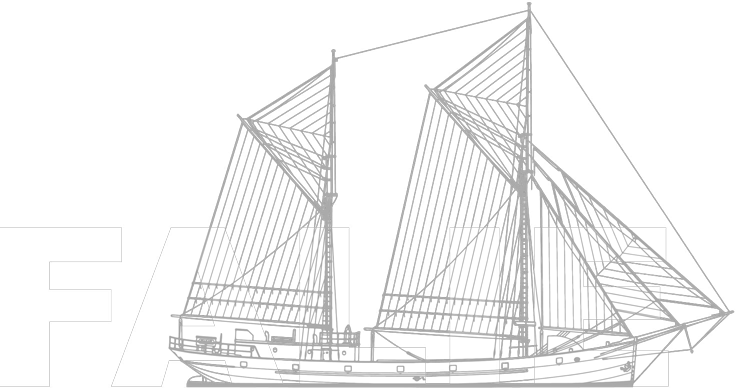Fast Facts
| Boat type | Gaff-rigged steel-hulled auxiliary motor ketch |
| Length Overall | 45.7m (150 feet) |
| Beam | 6.7m (22 feet) |
| Mean Draught | 2.4m (8 feet) |
| Height of Main Mast | 28.3m (93 feet) |
| Tonnage | 350 tonnes displacement (WIP – LYN TO CONFIRM) |
| Current Auxilary Motor | Grenaa 6 cylinder diesel engine |
| Current Owner | South Australian Government |
A brief history of the Falie
by Errol Ford
The Falie, has been berthed at McLaren Wharf in Port Adelaide since 2006, being out of marine survey, and is over 100 years old (built in 2019). As South Australia’s only remaining ketch on water, Falie is an important reminder of our State’s maritime history. Since 2009, a group of dedicated volunteers have been working on general maintenance to restore this historical asset, bringing her from a state of disrepair to a point where she now looks very presentable and contributes positively to the character of the Port’s Inner Harbor. Her engine room is in good order – including the main engine and generators, though they have not been started for some time. But more work is needed, particularly on her hull, to honour her history and to ensure she once again reaches her full potential.
Falie’s story crosses over many key themes in Australian history. After arriving in South Australia from the Netherlands in 1923, Falie spent much of her early working life in Spencer Gulf, working in the grain trade and servicing the regional communities through their ports. She sailed to Tasmania bringing timber to Adelaide for the SA Housing Trust and spent many years carrying explosives around the Australian coast, at times sailing in heavy weather, particularly in the Great Australian Bight. Another run between Adelaide and the American River often involved taking general cargo or a load of fuel and fertiliser and returning full of gypsum. A hard day’s work for the crew could include unloading a full cargo of fertiliser in large bags by shore crane, reloading by lumping bag grain into the hatch, rolling wool bags into position below, covering the hatch, then loading more wool on top and a full deck cargo of sheep for the market.
In World War 2 Falie served as a Navy vessel. In May 1940, the district Naval Officer visited the Falie in Hobart, in October that year she was commissioned as the HMAS Falie, sailing to New South Wales to be the inspection vessel outside of Sydney Heads. While she was on duty on the 31st of May 1942, three midget Japanese submarines entered Sydney Harbour. At 23:05 hours HMAS Falie crew radioed ashore that she had struck a submerged object, with three distinct bumps felt on the starboard side, Falie is recorded as having grazed midget submarine M24 the second submarine to enter harbour and reported this contact to Command. Later M24 fired a torpedo at USS Chicago but missed, the torpedo hitting billet Naval Ferry Kuttabul sinking, immediately killing 19 Australian and two British Naval Ratings.
The following year HMAS Falie was deployed to Papua New Guinea where she became heavily involved in the War as a supply ship and once carried troops behind enemy lines. During these war years, the crew consisted of a few naval officers and merchant seamen.
On the 31st of July 1945, HMAS Falie sailed from Madang for Finschhafen, to contact Rescue Tug Tancred for tow to Sydney. HMAS Falie was taken in tow four days later, on day five after provisioning and engine repairs the tow continued to Sydney. On day eight Tancred had fire coming from the engine room, crew abandoned ship and were picked up by HMAS Falie, Second Engineer was badly burned, signal requesting medical assistance for injured man sent. HMAS Falie steamed around at a safe distance waiting for fire to burn out. Captain and Officers reboarded. Having extinguished fire Captain of Tancred requested his crew to reboard which was done. HMAS Falie’s Commander observed Tancred to be drifting onto reefs and prepared to take her in tow, HMAS Falie took Tancred in tow to anchorage South of Kitabi Point. Eventually both these vessels arrived home after serving their country so well. Falie returned to her owners in 1946.
Recognising her historical significance, in 1982 Falie was purchased by the South Australian State Government for the 150 Jubilee celebrations and was restored to her original design but as a ketch. In 1986 she re-enacted the grain trade and visited 35 ports in 52 days. This re-enactment was very successful with many thousands visiting the ship at each port.
A 2006 survey report revealed that her hull plates had corroded to the point where she was unseaworthy. Falie was laid up and was in a sad state of repair when the volunteers were granted permission to board and start their maintenance.
“The Falie: a labour of love”
a documentary by Marty McNicol (2014).
Historic ketch Falie thanks Marty for generously allowing us to show it here.
Quiz
- How old is the ship FALIE?
- Where was FALIE built?
- In what year did FALIE arrive in Australia?
- Who was FALIE?
- Who were the shareholders of Spencer’s Gulf Transport Co?
- Who owns FALIE now?
- What was FALIE’s call sign?
- How long in metres is the ship FALIE?
- What was the usual cargo of the coastal traders?
- What is the role of the skipper?
- How many crew worked on a FALIE trip?
- How long was FALIE absent from Port Adelaide during the lightering season?


